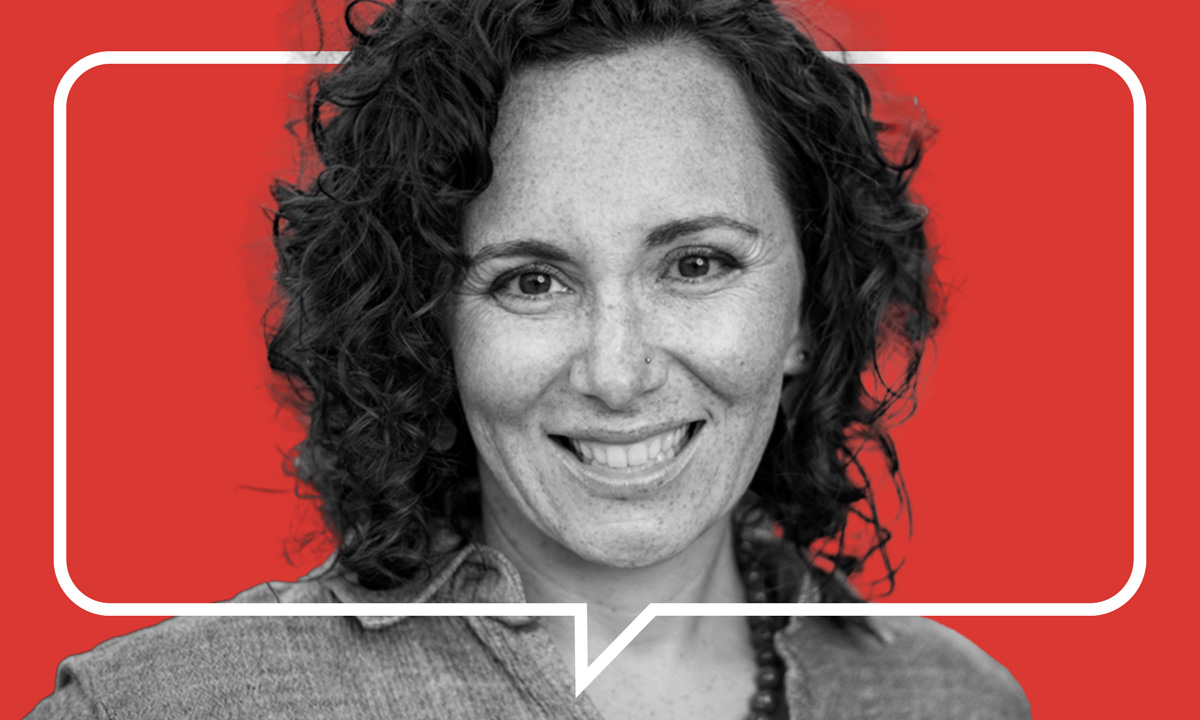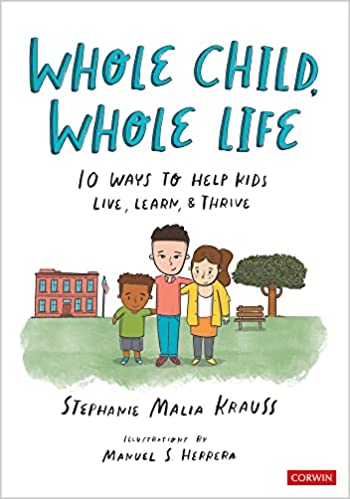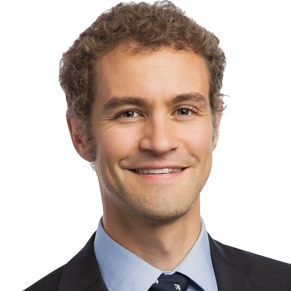‘Whole Child, Whole Life’ Book Offers 10 Ways For Kids to Live, Learn & Thrive
Countering current gloom, author charts ways to help children enjoy their childhood without constantly feeling at risk and to a imagine a happy future

Get stories like these delivered straight to your inbox. Sign up for The 74 Newsletter
Parents and caregivers have been struggling for pretty much as long as I’ve been in the game. Ten years ago, I had a playground chat with a mother of a toddler who felt like she was failing on all these complicated goals she had for her kid. This deeply unhappy stranger helped me realize something: Parental happiness is inversely proportional to the number of projects you’re including in your caregiving.
If you’re raising your child, hypothetically speaking, to be trilingual in Spanish, English, and Welsh; play a musical instrument; make varsity track by their freshman year in high school; secure admission to a top-flight college; and publish a peer-reviewed article by graduation … you’ve got a lot to worry about. And you’re all but guaranteeing that you’re going to feel terrible about yourself — and maybe about your kid.
But that’s the sort of insight that’s appropriate to a time of relative normalcy, a time when families can count on some basic social stability and standard functioning of things. It’s not as helpful in a moment when families are coming off a punishing global health catastrophe in a country with worsening political dysfunction.
Families in 2023 are juggling post-pandemic anxieties about their kids’ academic progress and their social and emotional well-being, health and safety. That’s more than most of us can carry with easy equanimity.
Now, instead of worrying about the various projects we’ve chosen for our parenting, we’re grinding ourselves just to get our kids back on some kind of recognizable track. As author Stephanie Malia Krauss puts it in her new book, Whole Child, Whole Life: 10 Ways to Help Kids Live, Learn, and Thrive, families are asking, “Will the kids be ok? What do they need? What can I do?”
I sat down with Krauss because I need answers to all three of those questions.
This interview has been lightly edited for clarity and length.
First of all, I have three kids, which makes five kids between us, right?
Yes!
OK. So we know what we’re talking about. I’ll put it plain: It’s a really, really hard time to be raising kids. I think we — individually and collectively — need to say that out loud until more people realize it. How are you doing now, as a human in this moment, as we dig out from the worst of the pandemic?
Parenting is extremely tricky right now, I think in large part because our kids are facing an onslaught of challenges and stresses and pressures that are either historic, but now feel intensified, or are legitimately new.
Right now, the livability and lovability of young people’s lives are more on the line than we have seen in recent history. There is a level of volatility and uncertainty that has been building over the past 20 years in the U.S. that we really saw come to a head during the pandemic — from global health issues, but also racial violence and economic recession. I would bring in increasingly extreme weather as another thing to think about.
Young people are living in the midst of so much unpredictability and it just feels deeply insecure, and it feels like their lives are on the line.
So how is this parenting experiment going? I’m trying to figure out ways to protect childhood while empowering my kids to be resourceful and skilled and capable in the world as it is and also giving them the kinds of resources and opportunities where it’s possible to thrive, including being able to thrive when times are really challenging.
I think you’re right. It’s a combination of old pressures that we’re maybe only sort of now attending to more thoroughly or noticing even … and this feeling of new challenges with heightened stakes. It drives more attention to how systems do or don’t meet kids’ usual — and new, in these stressful times — needs, right?
That’s also a conflict in the parenting experiment: I’m constantly aware of when I am complicit in signing my kid up for something that was designed for him to be a part of, but not designed with his learning and well-being in mind.
Some of this is simple. For example, as kids get older, they go to sleep later, and they need to sleep longer. When the school year comes around, I’m going to be waking my middle-schooler up every day at 5:30 a.m., when I know it’s bad for his brain and it’s bad for his body. He needs more sleep.
And he’s gonna struggle to go to bed at night when I know he really needs to sleep for his mental and physical health. And I’m going to do that every single morning, knowing that’s actually not good for him, but because it’s just a part of how he needs to go to school. So I think that there are so many moments like that, and you think, ‘Oh, in an ideal world, this is what you could do to support the development and the well-being of my kid.’
So it’s about figuring out how to negotiate and live in that mess.
Is that where Whole Child, Whole Life came from?
About 10 years ago, when my younger son was born, I left school leadership, where I had a number of questions about what young people actually need to be ready for the real world versus completing high school. So I go into national work, and soon realized that there are really smart people who are talking about these questions, they’re just not including a lot of people in the field.
So I decided to write a book as my love letter back to people raising and working with kids: Here’s what readiness really requires.
The [readiness] book came out at the height of the pandemic, just right in the middle. I’m doing a pandemic book tour from my basement, talking to educators, counselors, parents, social workers, anyone. I’m talking all about how the future is changing, what young people need to be ready for the world as it is, what they need to be ready for the future.
But every single time, somebody would ask the same version of this question at the end: ‘We really need to know what our kids need to be ready, but they are not well, and we are afraid that they could give up or burn out before they get to this future you’re talking about. What do our kids need to be well right now?’
I felt that question in the deepest parts of my bones. It was the question I was asking myself as a mom. So I put together this concept for what became Whole Child, Whole Life: 10 Ways to Help Kids Live, Learn, and Thrive.
Any concrete tips for staying sane?
Whole Child, Whole Life aims to explain what we need to know about young people’s physical, mental, cognitive, social, emotional, and even spiritual development. It tries to explain the practices that promote thriving, and why they matter, and puts it together in a way that is accessible and actionable.

There’s a set of practices that make up the bulk of the book. These 10 practices we need to practice as adults for kids. And eventually, as they get older, we need to practice it with them.
Eventually, kids internalize these 10 practices as self-care strategies, which means we, the adults, need to practice these things, too. We need to build community and belonging. We need to nurture healthy relationships. We need to attend to our past and present circumstances — all the same practices apply to us that apply to them.
When kids are with us, regardless of our title, we have a responsibility for them. They are in our care. And I tend to think about it as like: What is lifesaving? What is life extending and what is life giving for kids? What are my responsibilities at this particular moment?
Our kids are growing up in so many situations where danger is implicit. Imagine being a child, showing up to school every single day knowing that you might get shot, or you might get Covid and pass it to somebody vulnerable, like your grandmother, who lives in your house. And yet you just keep doing that every day and it’s normalized. It’s a part of what today’s kids are incorporating into their childhoods. So we have to think of the lifesaving techniques that kids need now.
And then there are the big questions that I think young people grapple with from a practical level all the way to an existential level. Am I going to live a long life? Is there a future for me? Can I even imagine what this world is going to look like? Are we all going to make it? Am I going to make it? Is my family going to make it?
How do we support them with life-extending techniques that help them imagine a long life and a good life. What do they need to imagine and secure that?
And then the life-giving pieces: How do we make sure that kids can actually enjoy their childhoods without constantly feeling like they’re at risk of something bad happening? A lot of them go through life with just a real and pending sense of doom that has been brought on by their lived experience and is totally reasonable to me.
What does it look like for us structurally and systemically to help kids get back to well?
First, we should do a very honest appraisal of what the risks and realities truly are for our kids so that we understand. We can then get about the business of figuring out: OK, so then what? Then what will it take for them to learn, to grow, to thrive? And what does that require then, of me, perhaps that I may not have been prepared to do before?
But we also have to look bigger. Our kids have the potential to live longer than anybody else with the right resources and opportunities. Science has advanced enough that we can keep people alive for a much longer time. Some people are projecting that our kids, as an expectation rather than an exception, could live a 100-year life.
Put that in the context of work. You and I were raised in a generation where hustle culture and putting in the hours and putting in the work was a matter of pride. It was what you did. But the idea of my children having to do that level of work over a 60- or 70- or even 80-year working life — that is not the life that I want for them, and I don’t think they could sustain it.
When I think about the prospect, the possibility of my kids having a 100-plus year life and then I think about the likelihood that in that 100 years there will continue to be volatility and uncertainty, acceleration, innovation, change, AI, and other advances and disruptions, it changes my view about what is important and why.
A first credential might matter less in the context of a longer life. We know that a degree is going to get you a better-paying job, that there are real economic benefits. But in the potential of a 100-year life, that is one step of many in a working journey.
What are some tangible ways we could refocus schools on children’s needs and development?
One of the things that I was so hopeful about as I wrote the book was that there are these 10 timeless practices that will always, no matter what is happening, support the health and well-being of young people. We know that learning is highly social and emotional. and that when young people are well, not only are they healthy, happy and whole, but they’re better learners and one day, workers.
In schools, we have all of these frameworks and prescriptive programs. We have tiered interventions. We have positive behavioral interventions and supports. We have discipline strategies, we have academic remediation. We have skills to prepare for the future. We have all of these pieces and requirements.
But we don’t actually have explicit, named frameworks for the art and science of taking care of children and human development. Schools need policies and practices that explicitly name and prioritize child well-being and development. I would love to see our schools commit to the whole child with a whole life orientation. Imagine schools answering the question: How do we help young people build lives and futures that they love?
We can focus on the everyday interactions that teachers and principals have full agency and decision-making power over. How are we building consideration of children’s development into the decisions that we’re making in the school culture, the commitments and the discipline decisions that we make? Our content and curricular choices? How are we setting up classroom learning? There are things like project-based learning and experiential learning that can light up all of the aspects of a kid’s well-being.
I would love for readers to look at Whole Child, Whole Life as kind of a sifter they can take their practices and policies through, and ask each time: What lights of well-being and thriving come on when we do this practice, when we implement this policy at home or at school? Is this helpful, or is this actually harmful to a young person’s well-being?’
Get stories like these delivered straight to your inbox. Sign up for The 74 Newsletter


